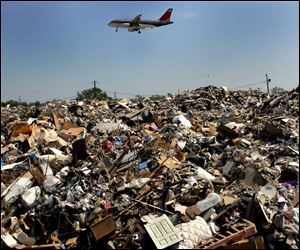
Gulf cleanup's waste could affect NW Ohio
10/10/2005
Debris from homes destroyed by Hurricane Katrina can contain a variety of toxic materials. The debris so far has remained in Louisiana, like this landfill in Kenner, near New Orleans.
Up and down the hurricane-ravaged Gulf Coast, officials are making hard decisions about what to do with all the stuff that gets torn down.
Uprooted trees and shrubs? A no-brainer: Burn 'em.
Things get dicey, though, when it comes to buildings, homes, and cars wrecked by the high winds and flooding. Ohio, a popular state for garbage haulers, could have a stake in how things are sorted.
Jim Pogue, an Army Corps of Engineers spokesman for the Gulf Coast demolition program, acknowledged that many of the older structures damaged by Hurricanes Katrina and Rita have lead-based paint, asbestos, arsenic, and other materials that officials don't want incinerated, which would put it into the air.
Cars have mercury switches, as well as other pollutants. Televisions, computers, and other electronics destroyed in the natural disasters also pose a hazard.
Decisions on how much to burn and how much to bury will be tough. Even with environmental waivers, officials still don't want to burn too much, which could affect the asthma rate in industrialized regions. Even in calm times. some areas struggle with air-pollution issues.
In New Orleans, an additional threat goes beyond the list of chemical hazards: Formosan termites.
Known as somewhat of a super termite because of its hardiness and ability to destroy, the Formosan is an Asian pest that made its way into New Orleans and a few other Southern ports as far back as World War II. The Crescent City has spent billions attacking it in its historic French Quarter by drilling holes through sidewalks and regularly injecting pesticides. But even that hasn't eradicated the pest.
One of the concerns is that the termites could fan out across North America if infested debris from New Orleans is transported via garbage trucks or rail cars.
The timing of the Gulf Coast cleanup isn't lost on the Ohio EPA, which in 2001 began pressing state legislators to close loopholes for 69 landfills licensed to take construction and demolition debris. The agency wants authority over those landfills and new rules that would bring them more in line with landfills that hold household garbage. Construction-and-demolition debris landfills exist in 33 Ohio counties, including Lucas, Wood, Hancock, and Allen.
Linda Oros, Ohio EPA spokesman, said the agency became more suspicious as complaints arose about the pulverized waste it was accepting. Nobody is quite sure what's in it, she said.
Last month, the Ohio EPA released results of tests on samples drawn from nine such landfills in eastern and southern Ohio. The result showed toxic chemicals at levels far exceeding background levels for Ohio groundwater.
While the Ohio EPA says the test results are merely a snapshot of the problem and not meant to represent the typical situation, two of the most dangerous levels of contaminants - arsenic and lead - were 36 and 14 times greater than what they were supposed to be, respectively.
Two others, cadmium and ammonia nitrogen, were found at 61 and 87 times above background levels, respectively.
A state legislative committee recently concluded that construction-and-demolition debris landfills need tighter controls.
Jack Shaner, Ohio Environmental Council spokesman, said more sampling and stricter measures aimed at protecting groundwater are long overdue.
He said it "defies logic to think you can heap arsenic-treated wood, vinyl siding, lead flashing, and mercury-laced fluorescent lights, switches, and thermostats in a landfill and not need to build in stronger siting criteria."
But Ms. Oros and others believe Ohio may be acting too late to protect the state's groundwater from potential hurricane waste moving north.
"Any legislation Ohio enacts would probably not be in place to impact what's going on in New Orleans," she said.
So far, nothing from the New Orleans area has left Louisiana. Much of the scrap metal is likely to be sent off to the Far East, Mr. Pogue said.
With its high water tables, Louisiana can't just dig pits anywhere. Ohio, on the other hand, has a glut of landfill space. But it's unclear if the trash would be hauled this far north.
"We think it's probably unlikely it would come this far north, but we really don't know," Ms. Oros said.
Activists aren't so sure.
"Ohio is already outed as the place to dump this waste," Mr. Shaner said. "We have rock-bottom tipping fees, decades of existing capacity, more permits pending for new facilities, and an unwittingly excellent transportation network."
In testimony presented in May to state legislators, Mr. Shaner quoted a Sept. 17, 2004, edition of an industry newsletter, Construction and Demolition Recycler, that said Ohio's construction-and-demolition debris landfills are the "final resting place of choice" for that type of waste because of low costs and willingness to accept pulverized material. "I think the word is out in industry that Ohio is your one-stop shop," he said.
Contact Tom Henry at: thenry@theblade.com or 419-724-6079.